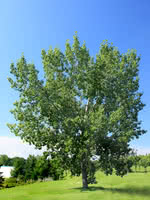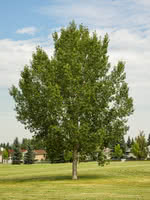Mon-Fri 9am - 5pm Mountain time
Northwest Poplar vs Balsam Poplar
Populus balsamifera
Populus x jackii Northwest
Balsam Poplar is a hardy, fast-growing deciduous tree that is Native to Canada east of the Rockies.
We grow them in two variations. Sometimes they are a male clones, so they don't produce fluff. Other times, we grow them from seed, which will result in fluff. The detailed descriptions (see below) will tell you which is which.
Northwest Poplar is a large and fast-growing tree. Due to its wide spread, this tree makes a great shade or shelterbelt tree. Northwest Poplar tolerates partial shade, drought, and most types of soil. This poplar produces no fuzz.
Northwest Poplar continues to be popular as a shelterbelt species due to the great cost savings that come from the wide spread of the branches. It is a staff favorite because of the wonderful shade it provides all summer long.
Balsam Poplar Quick Facts
Northwest Poplar Quick Facts
In row spacing: 2.4 - 3 m (8 - 10 ft)
In row spacing: 2.4 - 3 m (8 - 10 ft)

